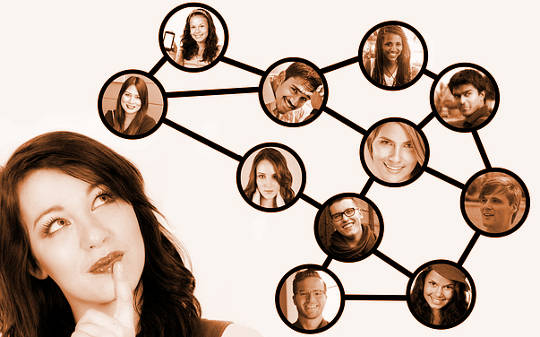
A person who is nice to you
but rude to the waiter is not a nice person.
— Dave Barry, humorist
One day I took a break from writing this book and went to the grocery store. At checkout, I placed my romaine lettuce, pears, cheeses, eggs, olives, and artichoke hearts on the conveyor belt, and when the person before me finished paying, I eased forward and slid my credit card in the machine. I looked up at the cashier anticipating a greeting. He averted his eyes. I was surprised that he didn’t ask me the usual questions: “How are you today?” and, “Did you find everything okay?”
I felt a chill, and a sense of alienation. Then I thought: “Hey, I’m writing this book on the art of connection, and I’ve just written all these notes about accessibility and openness. Maybe there’s a way to connect with this guy who looks like he might be having a rough day.”
During this inner dialogue, I noticed the prominent display of an impulse item next to the register — a snack bar made of bison, cranberries, and bacon. This seemed laughably disgusting to me, and I wondered what the cashier thought. So I decided, on impulse, to risk connecting. I asked him, “Do people really buy this? Have you tried it?”
“The flavors are actually pretty decent,” he said, still looking rather grim, “but the texture is disgusting!”
We both cracked up laughing as we exchanged a gleeful glance. I hope it brightened his day. I know it brightened mine.
Practicing The Art of Connection
Practicing the art of connection in such small, seemingly insignificant everyday actions is the key to being able to utilize it when you’re confronting a challenge with someone at work or a crisis in any relationship. As you explore building rapport with cashiers, waiters, and others, you’ll be setting the stage for greater skill in building the relationships that matter the most, whether in business or at home. If you’re a cashier, you’ll strengthen your immune system and elevate your mood through making positive connections with customers. If you’re a waiter, you’ll do more than raise oxytocin levels; you’ll also receive bigger tips.
Psychologist Leo Buscaglia (1924–1998), known affectionately as Dr. Love, was devoted to helping others focus on what really matters in life. He commented on the power of seemingly minor everyday interactions: “Too often we underestimate the power of a touch, a smile, a kind word, a listening ear, an honest compliment, or the smallest act of caring, all of which have the potential to turn a life around.” Imagine the goodwill, engagement, and brand loyalty generated by an organization that harnesses this power.
A Leadership Secret for Managing Energy
The launch party for Arianna Huffington’s Thrive Global in downtown New York City was a madhouse! Thumping loud music, way too many people jostling around in the space, massive sensory overload. In the midst of the craziness, I was introduced to Abby Levy, the CEO of Thrive. Abby did something that transformed my experience of the evening: for the twenty seconds we spoke she gave me her full attention. (And she generously offered a private tour at a quieter time.) In a graceful and efficient way, she recognized my existence. It was a moment of I–Thou.
These brief moments, like my interaction with the cashier, can make a surprising difference in the quality of our lives and our effectiveness as leaders, according to Jane Dutton, professor of business administration and psychology at the University of Michigan Ross School of Business and coauthor of How to Be a Positive Leader: Small Actions, Big Impact. After studying the phenomenon of successful leadership for decades, Dutton concludes, “Leaders can bring out the best in themselves and others through high-quality connections (HQCs).”
How You Know You’ve Had A High-Quality Connection (HQC)
Dutton invites us to consider:
Think of the last time an interaction at work literally lit you up. Before the interaction, you may have felt depleted, tired, or simply neutral. After the interaction, even if it was brief, you had a greater energy and capability for action. This sense of heightened energy is real, and it is an important indicator that you are engaged in a high-quality connection.
Dutton and her colleagues make a compelling, evidence-based case for the benefits of HQCs.
They’ve shown that people who have more high-quality connections:
- are physically and psychologically healthier
- display greater cognitive functioning and broader capabilities for thinking
- are more open to learning
- are more creative and engaged at work
For organizations, the implications are profound. Dutton explains that HQCs promote “organizational effectiveness in terms of greater efficiency and higher-quality performance.” She adds, “The beauty of high-quality connections is they do not require significant time to build, because they can be created in the moment.”
Adopt an HQC Mindset
In 1982, author Anne Herbert jotted down the phrase “Practice random acts of kindness and senseless acts of beauty” in a creative reinterpretation designed as an antidote to media reports of “random acts of violence and senseless acts of cruelty.” Herbert’s musing led to a book entitled Random Kindness and Senseless Acts of Beauty and innumerable bumper stickers, T-shirts, and graffiti.
One of the simplest ways to practice the art of connection is to look for opportunities to perform acts of intentional, deliberate connection and kindness in daily life. Smile and make eye contact with the teller at the bank and the clerk at the pharmacy. Hold a door open, slow down to allow another driver to enter your lane, offer your seat on a crowded subway, help someone get carry-on luggage down from the overhead bin.
Notice how you feel when you do these simple acts. You’ll delight others, but you’ll also find that you feel better, more energized and connected.
Copyright ©2017 by Michael J. Gelb.
Reprinted with permission from New World Library
www.newworldlibrary.com.
Article Source
The Art of Connection: 7 Relationship-Building Skills Every Leader Needs Now
by Michael J. Gelb.
 These days, it’s often easier to avoid face-to-face contact in favor of technological shortcuts. But as Michael Gelb argues in this compelling, entertaining book, the meaningful relationships that come from real interaction are the key to creating innovative ideas and solving our most intractable problems. In The Art of Connection, Gelb offers readers seven methods of developing this essential rapport in their professional and personal lives.
These days, it’s often easier to avoid face-to-face contact in favor of technological shortcuts. But as Michael Gelb argues in this compelling, entertaining book, the meaningful relationships that come from real interaction are the key to creating innovative ideas and solving our most intractable problems. In The Art of Connection, Gelb offers readers seven methods of developing this essential rapport in their professional and personal lives.
Click here for more info and/or to order this book.
About the Author
 Michael J. Gelb is the author of The Art of Connection and has pioneered the fields of creative thinking, accelerated learning, and innovative leadership. He leads seminars for organizations such as DuPont, Merck, Microsoft, Nike, Raytheon, and the University of Virginia’s Darden School of Business. He is the coauthor of Brain Power and author of How to Think Like Leonardo da Vinci and several other bestsellers. His website is www.MichaelGelb.com
Michael J. Gelb is the author of The Art of Connection and has pioneered the fields of creative thinking, accelerated learning, and innovative leadership. He leads seminars for organizations such as DuPont, Merck, Microsoft, Nike, Raytheon, and the University of Virginia’s Darden School of Business. He is the coauthor of Brain Power and author of How to Think Like Leonardo da Vinci and several other bestsellers. His website is www.MichaelGelb.com
Books by this Author
at

Thanks for visiting InnerSelf.com, where there are 20,000+ life-altering articles promoting "New Attitudes and New Possibilities." All articles are translated into 30+ languages. Subscribe to InnerSelf Magazine, published weekly, and Marie T Russell's Daily Inspiration. InnerSelf Magazine has been published since 1985.

Thanks for visiting InnerSelf.com, where there are 20,000+ life-altering articles promoting "New Attitudes and New Possibilities." All articles are translated into 30+ languages. Subscribe to InnerSelf Magazine, published weekly, and Marie T Russell's Daily Inspiration. InnerSelf Magazine has been published since 1985.
























